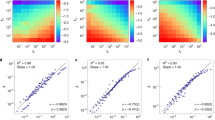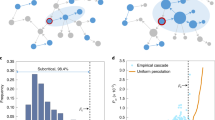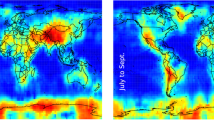Abstract
Previous research has suggested that well-connected nodes in a network (commonly referred to as hubs) are better at spreading information than those with fewer connections (ordinary users). Here we investigate the roles of nodes with different numbers of connections by studying how people share news online. Quantitative analysis shows that users without many connections can sometimes spread news more effectively than well-connected users when the diffusion pattern has dendrite-like paths that reach far into the network, leading to a non-Gaussian distance distribution. When the hubs dominate, however, the distribution is Gaussian. Enhanced interactions among ordinary users are the key to the emergence of non-Gaussian characteristics. Finally, we introduce a message-passing model that reproduces the observed diffusion features. This model shows that patterns dominated by either hubs or ordinary users can be clearly demarcated by measuring the average number of forwards.
This is a preview of subscription content, access via your institution
Access options
Access Nature and 54 other Nature Portfolio journals
Get Nature+, our best-value online-access subscription
$29.99 / 30 days
cancel any time
Subscribe to this journal
Receive 12 digital issues and online access to articles
$119.00 per year
only $9.92 per issue
Buy this article
- Purchase on Springer Link
- Instant access to full article PDF
Prices may be subject to local taxes which are calculated during checkout







Similar content being viewed by others
Data availability
The headlines of all the news stories were collected from the hot news website of Sina News Center (http://news.sina.com.cn/hotnews/). We asked a commercial institution (https://www.shenjianshou.cn/) to help us collect data on Sina Weibo (http://weibo.com/). The downloaded data include all the posts for each piece of news (that is, their respective user interactions and the follower counts of the users) that are publicly available on Sina Weibo (users with privacy restrictions are not included in the dataset). The data that support the findings of this study are available at https://www.researchgate.net/publication/328783349_data_of_news.
Code availability
Code for the data analysis and model simulation is available at https://www.researchgate.net/publication/328783349_data_of_news. The code was run using Python 238 and Matlab R2015b39 for data analysis and Matlab R2015b for model simulation.
References
Granovetter, M. Threshold models of collective behavior. Am. J. Sociol. 83, 1420–1443 (1978).
Christakis, N. A. & Fowler, J. H. The spread of obesity in a large social network over 32 years. N. Engl. J. Med. 357, 370–379 (2007).
Christakis, N. A. & Fowler, J. H. The collective dynamics of smoking in a large social network. N. Engl. J. Med. 358, 2249–2258 (2008).
Fowler, J. H. & Christakis, N. A. Dynamic spread of happiness in a large social network: longitudinal analysis over 20 years in the Framingham Heart Study. BMJ 337, a2338 (2008).
Barrat, A., Barthélemy, M. & Vespignani, A. Dynamical Processes on Complex Networks (Cambridge Univ. Press, 2008).
Fowler, J. H. & Christakis, N. A. Cooperative behavior cascades in human social networks. Proc. Natl Acad. Sci. USA 107, 5334–5338 (2010).
Lazarsfeld, P. F., Berelson, B. & Gaudet, H. The People’s Choice: How the Voter Makes Up His Mind in a Presidential Campaign (Columbia Univ. Press, 1948).
Katz, E. & Lazarsfeld, P. F. Personal Influence (Free Press, 1955).
Aral, S. & Walker, D. Identifying influential and susceptible members of social networks. Science 337, 337–341 (2012).
Wang, W., Tang, M., Shu, P. P. & Wang, Z. Dynamics of social contagions with heterogeneous adoption thresholds: crossover phenomena in phase transition. New J. Phys. 18, 013029 (2016).
Lee, E. & Holme, P. Social contagion with degree-dependent thresholds. Phys. Rev. E 96, 012315 (2017).
Yang, W., Cao, L., Wang, X. F. & Li, X. Consensus in a heterogeneous influence network. Phys. Rev. E 74, 037101 (2006).
Lin, Y. T., Yang, H. X., Rong, Z. H. & Wang, B. H. Effects of heterogeneous influence of individuals on the global consensus. Int. J. Mod. Phys. C 21, 1011–1019 (2010).
Xiong, F., Liu, Y. & Zhu, J. Competition of dynamic self-confidence and inhomogeneous individual influence in voter models. Entropy 15, 5292–5304 (2013).
Liang, H. L., Yang, Y. P. & Wang, X. F. Opinion dynamics in networks with heterogeneous confidence and influence. Physica A 392, 2248–2256 (2013).
Schmidt, A. L. et al. Anatomy of news consumption on Facebook. Proc. Natl Acad. Sci. USA 114, 3035–3039 (2017).
Deffuant, G., Neau, D., Amblard, F. & Weisbuch, G. Mixing beliefs among interacting agents. Adv. Complex Syst. 3, 87–98 (2000).
Del Vicario, M. et al. The spreading of misinformation online. Proc. Natl Acad. Sci. USA 113, 554–559 (2016).
Centola, D. & Macy, M. Complex contagions and the weakness of long ties. Am. J. Sociol. 113, 702–734 (2007).
Centola, D. The spread of behavior in an online social network experiment. Science 329, 1194–1197 (2010).
Watts, D. J. A simple model of global cascades on random networks. Proc. Natl Acad. Sci. USA 99, 5766–5771 (2002).
Onnela, J. P. & Reed-Tsochas, F. Spontaneous emergence of social influence in online systems. Proc. Natl Acad. Sci. USA 107, 18375–18380 (2010).
Zheng, M. H., Lü, L. Y. & Zhao, M. Spreading in online social networks: the role of social reinforcement. Phys. Rev. E 88, 012818 (2013).
Centola, D. How Behavior Spreads: the Science of Complex Contagions (Princeton Univ. Press, 2018).
Romero, D. M., Meeder, B. & Kleinberg, J. Differences in the mechanics of information diffusion across topics: idioms, political hashtags, and complex contagion on twitter. In Proc. 20th International Conference on World Wide Web 695−704 (ACM, 2011).
Borge-Holthoefer, J. et al. The dynamics of information-driven coordination phenomena: a transfer entropy analysis. Sci. Adv. 2, e1501158 (2016).
Wang, W., Tang, M., Zhang, H. F. & Lai, Y. C. Dynamics of social contagions with memory of nonredundant information. Phys. Rev. E 92, 012820 (2015).
Wang, W., Shu, P. P., Zhu, Y. X., Tang, M. & Zhang, Y. C. Dynamics of social contagions with limited contact capacity. Chaos 25, 103102 (2015).
Pathria, R. K. Statistical Mechanics (Elsevier, 2005).
Bouchaud, J.-P. & Georges, A. Anomalous diffusion in disordered media: statistical mechanisms, models and physical applications. Phys. Rep. 195, 127–293 (1990).
Watts, D. J. & Dodds, P. S. Influentials, networks, and public opinion formation. J. Consum. Res. 34, 441–458 (2007).
Roch, C. H. The dual roots of opinion leadership. J. Polit. 67, 110–131 (2005).
Freeman, L. C. Centrality in social networks conceptual clarification. Soc. Networks 1, 215–239 (1979).
Friedkin, N. E. Theoretical foundations for centrality measures. Am. J. Sociol. 96, 1478–1504 (1991).
Bonacich, P. Power and centrality: a family of measures. Am. J. Sociol. 92, 1170–1182 (1987).
Albert, R. & Barabási, A.-L. Statistical mechanics of complex networks. Rev. Mod. Phys. 74, 47–97 (2002).
Kitsak, M. et al. Identification of influential spreaders in complex networks. Nat. Phys. 6, 888–893 (2010).
Hetland, M. L. Beginning Python: from Novice to Professional 2nd ed. (Apress, 2008).
Chapman S. J. Essentials of Matlab Programming 2nd ed., (Cengage Learning, 2008).
Acknowledgements
This work was supported by the National Natural Science Foundation of China (grant nos. 11775034 and 11375093). The funders had no role in study design, data collection and analysis, decision to publish or preparation of the manuscript.
Author information
Authors and Affiliations
Contributions
X.W., Y.L. and J.X. contributed equally to all parts of the research and writing.
Corresponding authors
Ethics declarations
Competing interests
The authors declare no competing interests.
Additional information
Publisher’s note: Springer Nature remains neutral with regard to jurisdictional claims in published maps and institutional affiliations.
Supplementary Information
Supplementary Information
Supplementary Methods 1−8, Supplementary Notes 1−5, Supplementary Tables 1−6, Supplementary Figures 1−17 and Supplementary References.
Rights and permissions
About this article
Cite this article
Wang, X., Lan, Y. & Xiao, J. Anomalous structure and dynamics in news diffusion among heterogeneous individuals. Nat Hum Behav 3, 709–718 (2019). https://doi.org/10.1038/s41562-019-0605-7
Received:
Accepted:
Published:
Issue Date:
DOI: https://doi.org/10.1038/s41562-019-0605-7
This article is cited by
-
The role of the big geographic sort in online news circulation among U.S. Reddit users
Scientific Reports (2023)
-
Finding early adopters of innovation in social networks
Social Network Analysis and Mining (2022)
-
Cooperation patterns of members in networks during co-creation
Scientific Reports (2021)
-
Topological measures for identifying and predicting the spread of complex contagions
Nature Communications (2021)



